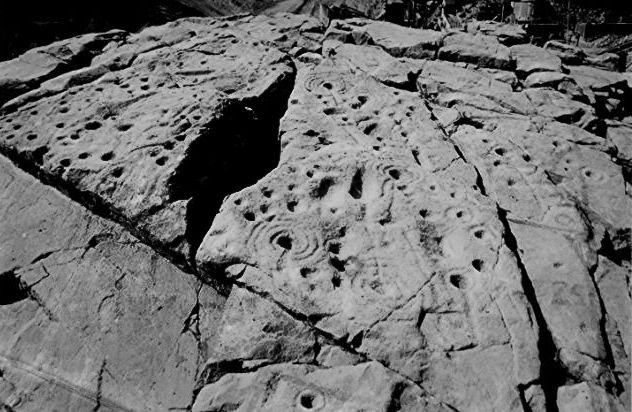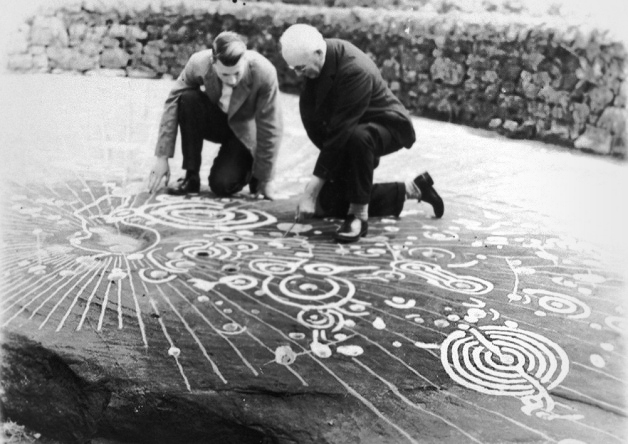



The 5,000 year old Cochno Stone measures 42ft by 26ft and is considered one of the finest examples of 'cup and ring' rock carvings found in the United Kingdom. Located in West Dunbartonshire, it has been designated a scheduled monument and of national importance to Scotland, due to its Bronze Age significance. 50 years ago the Cochno Stone was buried under soil at the recommendation of archaeologists, fearing it may suffer further damage by vandalism.
It now appears the Cochno Stone may become visible to the world once more as the local council are considering revealing the spectacular stone once again. Cupules and 'cup and ring' carvings have been found around the world and are one of the most ancient forms of expression found in rock art.

Alexander McCallum, a history researcher states multiple interpretations for the carvings exsist: "Some people think that the Cochno Stone is a map showing the other settlements in the Clyde Valley - that's one of the theories. I think it was probably used for lots of things; it was never used for just one thing and over hundreds of years it changed use."
"As far as the symbolism goes, some believe it's a portal, of life and death, rebirth, a womb and a tomb - people believed in reincarnation, so they would go into the earth and then come out again."
A spokeswoman for Historic Scotland said: "We have had no recent approaches with specific proposals. In the 50 years since it was covered over, there have been significant advances in recording techniques and our understanding of conservation, and we would be happy to support any considered and adequately resourced proposals to uncover it, in conjunction with the local authority and the landowner."
West Dunbartonshire Council said it would "seek professional advice on the implications of uncovering the area", adding: "Our priority is to ensure this renowned site is preserved and protected in a sustainable way."
* Credit to The Scotsman
by Bradshaw Foundation
Monday 04 December 2023
by Bradshaw Foundation
Friday 30 June 2023
by Bradshaw Foundation
Thursday 06 April 2023
by Bradshaw Foundation
Thursday 24 November 2022
by Bradshaw Foundation
Tuesday 27 September 2022
by Bradshaw Foundation
Thursday 08 September 2022
by Bradshaw Foundation
Tuesday 19 July 2022
by Bradshaw Foundation
Monday 06 June 2022
by Bradshaw Foundation
Friday 11 March 2022
by Bradshaw Foundation
Wednesday 02 March 2022
by Bradshaw Foundation
Thursday 26 August 2021
by Bradshaw Foundation
Monday 16 August 2021
by Bradshaw Foundation
Tuesday 06 July 2021
by Bradshaw Foundation
Thursday 06 May 2021
by Bradshaw Foundation
Thursday 06 May 2021
by Bradshaw Foundation
Tuesday 16 March 2021
by Bradshaw Foundation
Monday 04 December 2023
by Bradshaw Foundation
Friday 30 June 2023
by Bradshaw Foundation
Thursday 06 April 2023
by Bradshaw Foundation
Thursday 24 November 2022
by Bradshaw Foundation
Tuesday 27 September 2022
by Bradshaw Foundation
Thursday 08 September 2022
by Bradshaw Foundation
Tuesday 19 July 2022
by Bradshaw Foundation
Monday 06 June 2022
by Bradshaw Foundation
Friday 11 March 2022
by Bradshaw Foundation
Wednesday 02 March 2022
by Bradshaw Foundation
Thursday 26 August 2021
by Bradshaw Foundation
Monday 16 August 2021
by Bradshaw Foundation
Tuesday 06 July 2021
by Bradshaw Foundation
Thursday 06 May 2021
by Bradshaw Foundation
Thursday 06 May 2021
by Bradshaw Foundation
Tuesday 16 March 2021
Friend of the Foundation











